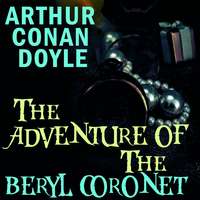The Adventure of the Beryl Coronet
Артур Конан Дойл
"The Adventure of the Beryl Coronet", one of the 56 short Sherlock Holmes stories written by Sir Arthur Conan Doyle, is the eleventh of the twelve stories collected in The Adventures of Sherlock Holmes. The story was first published in Strand Magazine in May 1892. A banker, Mr. Alexander Holder of Streatham, makes a loan of ?50,000 to a socially prominent client, who leaves a beryl coronet—one of the most valuable public possessions in existence—as collateral. Holder feels that he must not leave this rare and precious piece of jewellery in his personal safe at the bank, and so he takes it home with him to lock it up there. He is awakened in the night by a noise, enters his dressing room, and is horrified to see his son Arthur with the coronet in his hands, apparently trying to bend it. Holder's niece Mary comes at the sound of all the shouting and, seeing the damaged coronet, faints dead away. Three beryls are missing from it. In a panic, Mr. Holder travels to see Holmes, who agrees to take the case. The case against Arthur seems rather damning, yet Holmes is not convinced of his guilt. Why is Arthur refusing to give a statement of any kind? How could Arthur have broken the coronet (even Holmes, who has exceptionally strong hands, cannot do it) and without making any noise? Could any other people in the household be involved, such as the servants, or Mary? Could some visitor, such as the maid's wooden-legged suitor, or Arthur's rakish friend Sir George Burnwell, have something to do with what happened to the coronet? The failure to resolve the case will result in Mr. Holder's dishonour, and a national scandal. Famous works of the author Arthur Conan Doyle's: «A Study in Scarlet», «Silver Blaze», «The Hound of the Baskervilles», «The Yellow Face», «A Scandal in Bohemia», «The Red-Headed League», A Case of Identity", «The Boscombe Valley Mystery», «The Five Orange Pips», «The Man with the Twisted Lip», «The Blue Carbuncle», «The Speckled Band», «The Engineer's Thumb», «The Noble Bachelor», «The Beryl Coronet», «The Copper Beeches» and many more.
- Категория: зарубежные детективы
- Правообладатель: Мультимедийное издательство Стрельбицкого
- Возрастное ограничение: 12+
- Легальная стоимость: 49.00 руб.





